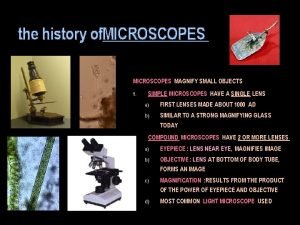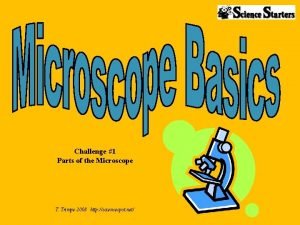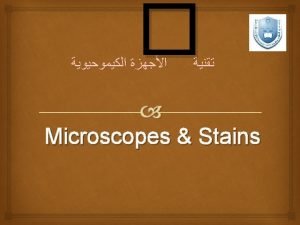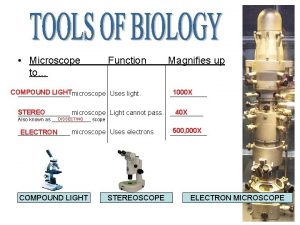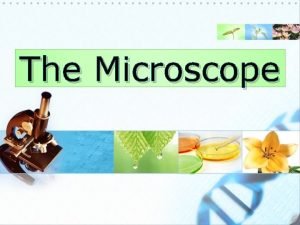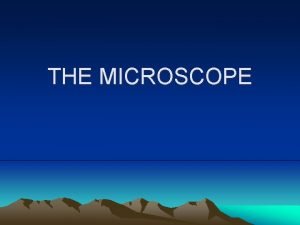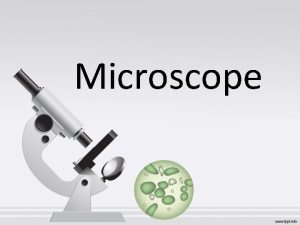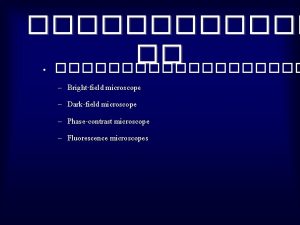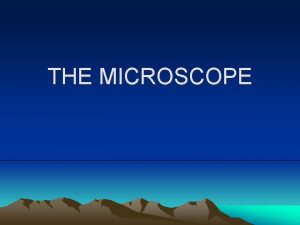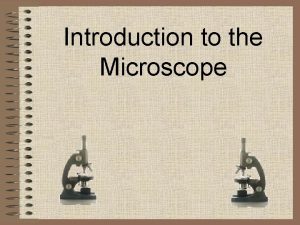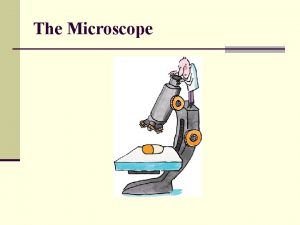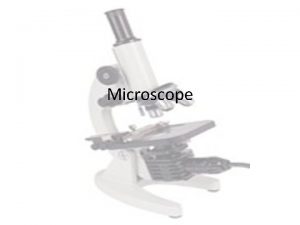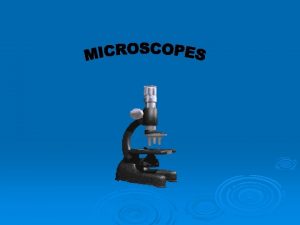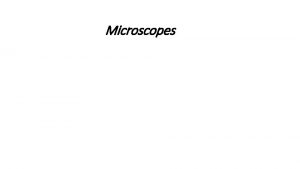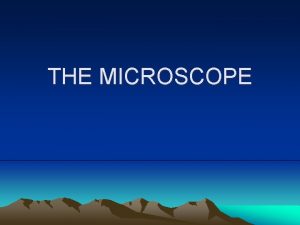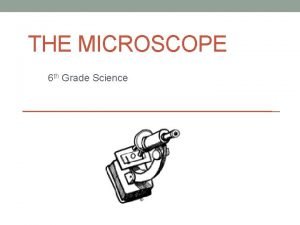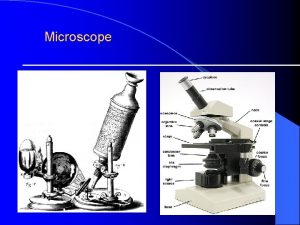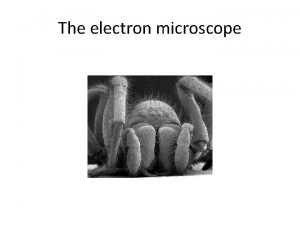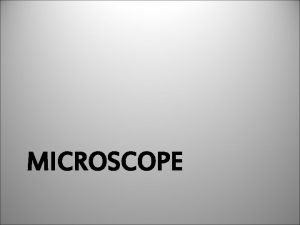What is the Microscope The microscope magnifies the







































- Slides: 39


What is the Microscope ? The microscope magnifies the images of objects that are invisible to the unaided human eye.

History of microscope

Simple Glass Magnifiers • More than 500 years ago. • In 1600 s, this “simple microscope” allowed scientists to see cells and bacteria • Problem: not enough magnification

Types of Microscope Light microscopy Bright field microscopy Dark field microscopy Phase-contrast microscopy Fluorescence microscopy Electron microscopy

Light Microscope Simple – uses a single lens Compound – uses a set of lenses or lens systems

Simple Light Microscope

First Compound Microscope Developed at the beginning of the 1600's, by the Janssen brothers and Galileo n Problem: images were blurred and had colored halos n

Light Compound Microscope n n n n n 1900 s, started using iron instead of brass (cheaper) 1 st type of microscope, most widely used light passes through 2 lenses a compound light microscope may have a single eye piece (monocular) or two eye pieces (binocular). Only one eyepiece (monocular) Oil immersion lens increases resolution because light does not refract 1 ocular/eyepiece ( 10 x magnification ). 3 objectives(4 x, 10 x and 40 x magnification ) Total magnification = magnification of objective lens X magnification of ocular lens Still used today



Bright-Field Microscopy Simplest optical microscopy illumination technique Uses visible light as source of illumination. The field of view is brightly lit so that organism and other structures are visible against it because of their different densities. Single stain or differential staining may be used depending on the properties of different structure and organism. Contrast comes from absorbance of light in the sample, or from staining. When the diaphragm is wide open the image is brighter and contrast is low. Total Magnification: (if 10 x ocular magnification is used) Range: 10 x-1000 x Widely used in histology , pathology , botany

Source: http: //www. austincc. edu/biocr/1406/labm/ex 3/prelab_3_8. htm


Dark-Field Microscopy Best for observing pale objects Specimen appears light against dark background Increases contrast and enables observation of more details Good for watching bacterial motion. A special condenser is used which cause light to reflect from the specimen at an angle. Total Magnification: Can range from those of compound microscopes (10 x to 1000 x) Used to observe living , unstained preparations.


Comparison of bright and darkfield Brightfield Microscopy Darkfield Microscopy Contrast is reversed in these modalities

Phase-Contrast Microscopy Type of light microscope Enhances contrast in micrographs by converting phase shifts of light waves into brightness Offers more contrast than brightfield microscopy Does not require the use of staining procedures which usually kill cells. Total magnification for phase contrast microscopes range from 40 x to 400 x Especially useful for examining living, unpigmented cells

Phase-contrast microscope


Fluorescence microscopy A fluorescence microscope is an optical microscope. Uses fluorescence and phosphorescence instead of, or in addition to, reflectionand absorption to study properties of organic or inorganic substances. Fluorescent-designed to detect fluorescent light, specimen must be dyed, ultraviolet light used


Electron Microscope Invented by Ernst Ruska in year 1933. An electron microscope (EM) is a type of microscope that uses an electron beam to illuminate a specimen and produce a magnified image. An electron microscope has greater resolving power than a light microscope. The have two types of EM : ( SEM ) … (TEM) Magnification can be done upto 2 million times

First Electron Microscope üInvented by Ernst Ruska ü Year-1933 ü He was awarded the Nobel Prize for physics for his invention in 1986

Types of Electron Microscope 1. Scanning electron microscope. ( SEM ) 2. Transmission electron microscope. (TEM )

SEM AND TEM PHOTOS SEM TEM

E. coli

HIV Virus

Microscope Vocabulary Magnification: increase of an object’s apparent size Resolution: power to show details clearly e n e r a Both e e s o t eded e g a m i r a clea

Types of stain 1. Simple staining – only one dye - Eg. Methylene blue , crystal violet. 2. Differential staining- more than one dye is used- Eg. Gram’s staining, Acid-fast staining. 3. Special staining – more than one dye used -Special structures are seen. Eg. Capsule staining, Spore staining.

Simple Stain v Methylene blue - stains animal cells to make nuclei more visible. v Crystal violet - stains cell walls purple when combined with a mordant. This stain is used in Gram staining v Malachite green - a blue-green counterstain to safranin in Gimenez staining for bacteria. This stain can also be used to stain spores. v Iodine - used as a starch indicator. When in solution, starch and iodine turn a dark blue color. v Bismarck Brown - colors acid mucins, a type of protein, yellow and may be used to stain live cells v Fuchsin - this stain is used to stain collagen, smooth muscle, or mitochondria v. Safranin - a nuclear stain used as a counterstain or to color collagen yellow.

Gram Stain DANISH BACTERIOLOGIST HANS CHRISTIAN GRAM (1880) Gram Stain- 1884 crystal violet (+) and iodine and ethanol decolorizer, and counterstained with safranin (-) Gram +=purple Gram - = red Gram non reactive= no stain Gram Variable= stain unevenly

Time Frame 1) 1 minute 2) 1 minute 3) 15 seconds 4) 1 minute Rinse with water between each step


Acid-Fast Stain – Type of differential stain – Used to detect organisms with a waxy substance in the cell wall – Useful for detecting Mycobacterium • Mycobacterium tuberculosis. • Mycobacterium leprae.

Special Stains 1 -Negative (capsule) stain: ( Nigrosin ink+ indian ink)

FLAGELLAR STAIN – SILVER STAIN: This stain increases the thickness of flagella – thus easy to see under light microscope.

References Different types of microscopes. (n. d. ). Retrieved April 4, 2015, from http: //www. slideshare. net/UTTAMKUMARDAS/different-types-of-microscopes. Electron Microscope Shanthakumar. (n. d. ). Retrieved April 4, 2015, from http: //www. slideshare. net/guestcd 4662/electron-microscope-shanthakumarjpg. Microscope types and use. (n. d. ). Retrieved April 4, 2015, from http: //www. slideshare. net/Ms. Allen. Bio/microscope-types-and-use? related=1 Electron microscopy. (n. d. ). Retrieved April 4, 2015, from http: //www. slideshare. net/suniu/electron-microscopy Microscope. (n. d. ). Retrieved April 4, 2015, from http: //www. slideshare. net/sarathy 4/microscope-10905635? related=3 Fluorescence microscope. (n. d. ). Retrieved April 4, 2015, from http: //en. wikipedia. org/wiki/Fluorescence_microscope

References Bacterial staining. (n. d. ). Retrieved April 4, 2015, from http: //www. slideshare. net/sasiprasad/bacterialstaining Fluorescent Microscopy. (n. d. ). Retrieved April 4, 2015, from http: //serc. carleton. edu/microbelife/research_method s/microscopy/fluromic. html
 Microscope questions and answers pdf
Microscope questions and answers pdf Difference between light microscope and electron microscope
Difference between light microscope and electron microscope Microscope mania compound light microscope
Microscope mania compound light microscope Sự nuôi và dạy con của hươu
Sự nuôi và dạy con của hươu Thế nào là hệ số cao nhất
Thế nào là hệ số cao nhất Diễn thế sinh thái là
Diễn thế sinh thái là Vẽ hình chiếu vuông góc của vật thể sau
Vẽ hình chiếu vuông góc của vật thể sau Lp html
Lp html Làm thế nào để 102-1=99
Làm thế nào để 102-1=99 Thế nào là mạng điện lắp đặt kiểu nổi
Thế nào là mạng điện lắp đặt kiểu nổi Lời thề hippocrates
Lời thề hippocrates đại từ thay thế
đại từ thay thế Vẽ hình chiếu đứng bằng cạnh của vật thể
Vẽ hình chiếu đứng bằng cạnh của vật thể Tư thế worms-breton
Tư thế worms-breton Quá trình desamine hóa có thể tạo ra
Quá trình desamine hóa có thể tạo ra Sự nuôi và dạy con của hổ
Sự nuôi và dạy con của hổ Các châu lục và đại dương trên thế giới
Các châu lục và đại dương trên thế giới Các loại đột biến cấu trúc nhiễm sắc thể
Các loại đột biến cấu trúc nhiễm sắc thể Thế nào là sự mỏi cơ
Thế nào là sự mỏi cơ Bổ thể
Bổ thể độ dài liên kết
độ dài liên kết Thiếu nhi thế giới liên hoan
Thiếu nhi thế giới liên hoan Chúa yêu trần thế alleluia
Chúa yêu trần thế alleluia điện thế nghỉ
điện thế nghỉ Fecboak
Fecboak Một số thể thơ truyền thống
Một số thể thơ truyền thống Hệ hô hấp
Hệ hô hấp Cong thức tính động năng
Cong thức tính động năng Số nguyên tố là số gì
Số nguyên tố là số gì đặc điểm cơ thể của người tối cổ
đặc điểm cơ thể của người tối cổ Tỉ lệ cơ thể trẻ em
Tỉ lệ cơ thể trẻ em Các châu lục và đại dương trên thế giới
Các châu lục và đại dương trên thế giới ưu thế lai là gì
ưu thế lai là gì Môn thể thao bắt đầu bằng từ chạy
Môn thể thao bắt đầu bằng từ chạy Tư thế ngồi viết
Tư thế ngồi viết Thẻ vin
Thẻ vin Hát kết hợp bộ gõ cơ thể
Hát kết hợp bộ gõ cơ thể Cái miệng nó xinh thế chỉ nói điều hay thôi
Cái miệng nó xinh thế chỉ nói điều hay thôi Mật thư tọa độ 5x5
Mật thư tọa độ 5x5 Từ ngữ thể hiện lòng nhân hậu
Từ ngữ thể hiện lòng nhân hậu
